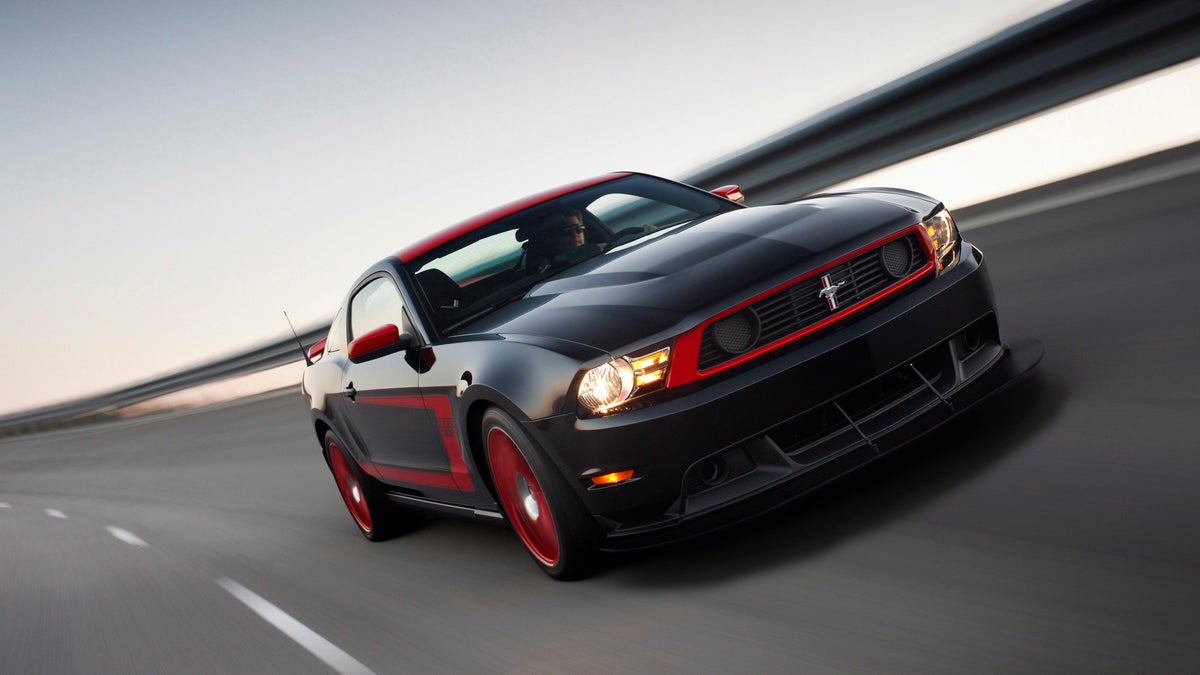Race-ready limited production 2012 Mustang Boss 302 unveiled
Ford today unveiled the limited-production track-oriented 2012 Mustang Boss 302, and 2012 Mustang Boss 302 Laguna Seca.

You might not remember the 1969 Mustang Boss 302. But if you do, you'll be even more excited about today's announcement of the 2012 Mustang Boss 302 and the 2012 Mustang Boss 302 Laguna Seca.
Based on the 2011 Mustang GT, the Boss 302 features upgrades to the engine output, brakes, suspension, interior, and exterior. It's lighter in weight and offers better aerodynamics and track performance, according to a Ford news release.
"The decision to build a modern Boss was not entered into lightly," said Derrick Kuzak, group vice president, Global Product Development. "The entire team at Ford felt the time was right and with the right ingredients, the world-class 2011 Mustang could support a successful, race-bred, worthy successor to the original Boss 302. For us that meant a production Mustang that could top one of the world's best--the 2010 BMW M3--in lap times at Laguna Seca. We met our expectations."
To achieve a top speed of 155 mph, Ford used the same twin independent variable camshaft timing (Ti-VCT) mechanism found on the Mustang GT. The Boss 302 also has aggressive control calibration that yields 440 horsepower and 380 pound-feet of torque.
The Boss 302 has a race-inspired clutch with upgraded friction materials that transmit power, and a short-throw, close-ratio six-speed manual transmission handles gear-change duties. Ford also used a 3.73-ratio rear axle with carbon fiber plates in the limited slip differential to improve torque handling and longevity. For those who want even more precise control over power delivery, a torque-sensing (Torsen) limited slip differential is an available option coupled with Recaro front seats, the company said.
To accommodate noise regulations and nonregulation situations, the attenuation disc is removable and includes a spacer plate sized to match aftermarket exhaust dump valves. If owners want to add a set of electric valves, they can undo two bolts on either side; the disc and spacer slide out and the valve will slide right in. And the side pipes are tuned so that drivers can run wide-open and the sound levels are comfortable and uniquely V-8.
When it comes to suspension and steering, Ford incorporated higher-rate coil springs on all four corners, stiffer suspension bushings and a larger-diameter rear stabilizer bar, and five settings on the shocks. Changing the settings takes a small flat-head screwdriver to turn the adjustment screw between one and five.
The Boss 302 rides on lightweight 19-inch black alloy racing wheels in staggered widths: 9 inches in front, 9.5 inches in the rear. The Pirelli PZero summer tires are sized specifically for each end of the vehicle, with the front wheels receiving 255/40ZR-19 tires, whereas the rear stays planted thanks to 285/35ZR-19 rubber, according to Ford.
"This car is wicked fast, so we put a lot of emphasis on giving it comparable stopping power," said Brent Clark, supervisor of the Mustang vehicle dynamics team. "We started with a race-proven brake system and tuned it specifically for the characteristics of the Boss 302 and its mission. They're the best brakes ever installed on a Mustang, and they give consistent, repeatable braking performance on the street and the track."
The Boss 302 isn't only about performance, it's also about a sporty, bad-boy look that is a throw back to its 1969 predecessor. Outside, the design is accented by an aerodynamically functional front splitter, designed to function at high speeds by efficiently managing the air under and around the car. The splitter helps to reduce underbody drag and front end lift while more effectively forcing air through a unique cooling system. And a spoiler at the rear of the car minimizes overall drag.
Inside, the driver is treated to Recaro buckets seats; dark metallic instrument panel finish, gauge cluster, and door panel trim; and an Alcantara suede steering wheel.

